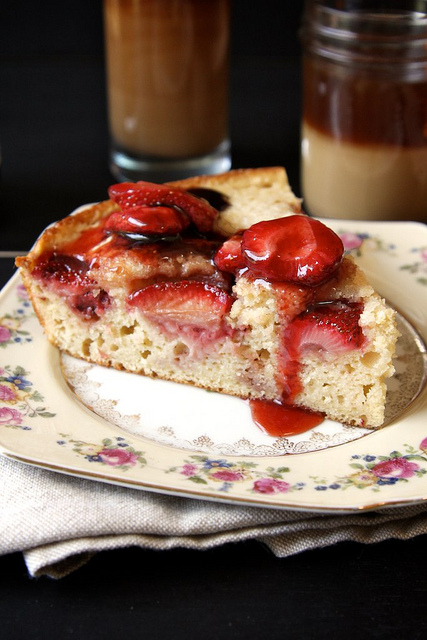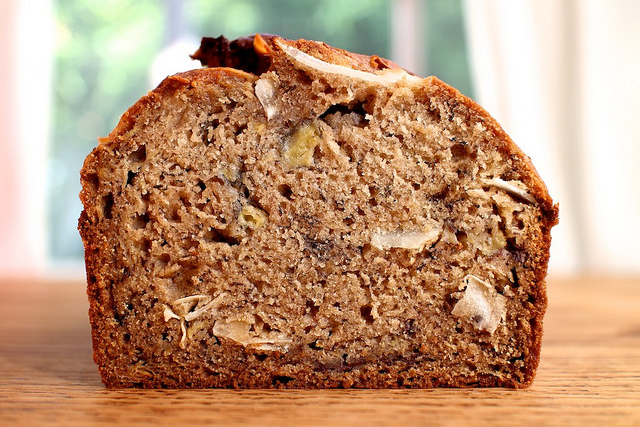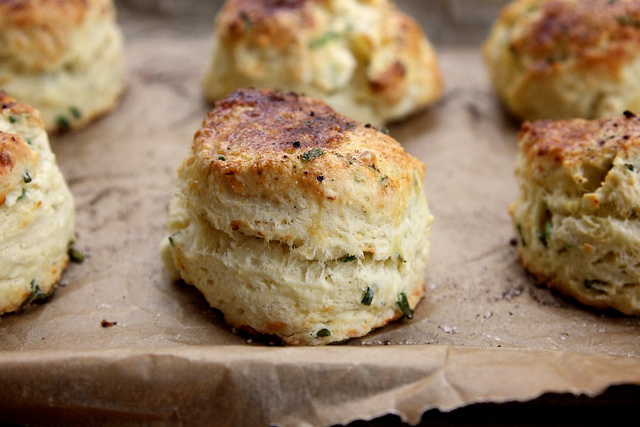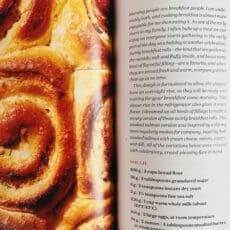
Let’s talk about buttermilk. More specifically, let’s talk about how I never have buttermilk in the refrigerator when I need it. Wwhhyy!?
What is buttermilk? Buttermilk is a slightly sour milk. The sourness of buttermilk comes from acids in the milk, most notably, lactic acids. Because the proteins in buttermilk are curdled, buttermilk is slightly thicker than regular milk, but not quite as thick as cream. Buttermilk is also usually much lower in fat than regular milk and cream.
Cultured buttermilk, as it is called in the United States these days, is a pasteurized milk product. A culture of lactic acid bacteria is added to low-fat milk to curdle and sour the milk. Many dairies also add tiny yellow colored flecks of butter to simulate, well… buttermilk.
Buttermilk is an important part of baking. The acidic milk combined with baking soda in a recipe is a baker’s dream. It’s helps add a lightness and tenderness to baked treats. When baking soda is combined with the lactic acids of buttermilk, the acid neutralizes the metallic taste of sodium carbonate. We talked about this in-depth in Baking 101: The Difference Between Baking Soda and Baking Powder.
What if you’re plum out of buttermilk? There are solutions…. let’s talk.
The Best Buttermilk Substitutes
Milk and Lemon or Vinegar
In a 1-cup measuring cup, add 1 Tablespoon of fresh lemon juice. Top the lemon juice with skim, low fat or whole milk. Stir and let sit for two minutes. After two minutes, your milk is both acidic and curdled. If you need 2 cups of buttermilk, add 1 tablespoon plus 1 teaspoon of lemon juice or vinegar to the milk. Two tablespoons aren’t necessary.
Milk and Yogurt
Stir 1/4 cup milk into 3/4 cup plain yogurt to create a nicely thick buttermilk substitute.
Milk and Cream of Tartar
Stir together 1 cup of milk and 1 3/4 teaspoon cream of tartar. To ensure that the mixture doesn’t get lumpy, mix the cream of tartar with 2 Tablespoons of milk. Once mixed add the rest of the cup of milk. Cream of tartar is an acid and will simulate the acidic environment of buttermilk in a pinch.
Non-Dairy Option: Almond Milk and Yogurt (with a splash of vinegar)
Stir 1/4 cup almond milk into 3/4 cup almond milk yogurt. Add a splash (about 1/2 teaspoon) vinegar to the mixture and stir well. Soy milk and yogurt can also be substituted for the almond milk products.
What We’re Making With Buttermilk
So soft and tender straight from the fryer. Don’t inhale and eat. Trust me.
Roasted Strawberry Buttermilk Cake
Soft cakes topped with ultra sweet, roasted strawberries.
Brown Butter Banana Bread with Rum and Coconut
Brown Butter and Buttermilk in their greatest union yet.
Feta Chive and Sour Cream Scones
Dream biscuits. On the savory side.










shannon skinner
I’m sorry but buttermilk has a fat content that is quite high so if you’re not using a 2 percent of whole milk before you ruin it by curdling it, you might just want to add a tad more fat. Curdling milk to make buttermilk is actually not the answer. Buttermilk is not fermented milk, it is a leftover product that comes from making butter. I make butter quite often and have better results when I use a higher fat content whipping cream. The fat content of the buttermilk that is left over is the same as the initial whipping cream. The yogurt idea is the best as it does have a natural fermentation but, again, buttermilk is not a fermented product, never has been until it was put on the shelf.
Suggestion: No buttermilk? In this 3/4 of a cup of buttermilk, I would add 2 more Tablespoons of butter into your milk and then heat it to melt the butter into it. That is how you make buttermilk. I know it’s different but from a person that has actually made buttermilk, this is how it is derived.
Dianna
I’m not understanding most of what you wrote…your first sentence didn’t make sense. In your directions for making buttermilk, are you saying, to make buttermilk, add 2 tablespoons butter to 3/4 cup milk, and that’s it?
Hilda M Rodriguez
Joy,
Have you or anybody have tried it with o% fat lactose free milk?
Gigi
Can i use powdered milk then add water?
joythebaker
Sure!
Margaret DiNegro
Can you use Real Lemon instead of fresh lemon? – Margaret
joythebaker
Sure! Shouldn’t be a problem!
Bobby
I don’t know if you’re familiar with a Russian drink called kefir, sounds like it also would be a good substitute? It’s much easier to find in my country. Of course, yoghurt is even more accessible, as I’m taking Bulgaria, but i”‘m curious.
shannon skinner
This would be a good substitute although a little thin
Linda Corbin
There is absolutely NOTHING wrong with simply putting one tablespoon of vinegar in a measuring cup and filling with milk until it reaches 8 oz.!! Why waste a lemon for this!? Ridiculous !
joythebaker
Cool, thanks.
Lesley Weatherford
Used unsweetened almond milk and recipe said add 2 Tbsp of lemon juice. It was too much, the batter is not thick enough and the mini muffins I made completely crumbled apart. I won’t risk it again, I’ll just go get buttermilk.
Damaris T Collins
Hi!…Just found out my love is for baking…since I’m a rookie, which would be the first instruments I should get to start my baking adventure?…
Thank you so much!
tin
hi! i thought its only here in the Philippines that buttermilk is nowhere to be found. So its a so american recipe when it calls for the use of buttermilk since even europeans dont find it most in their supermarket. How I wish dairy producing countries will find a way to reach us here… After reading these substitute of buttermilk from this site… you are the most helpful people on earth to tell us the best thing to do. Thank you so much for this info. You are God’s blessing to others…
mai
If i only need 1/2 cup of buttermilk, how can i substitute it using plain yogurt and milk?
Pls help!tnx
joythebaker
The answer in the post can help you in the “milk yogurt” section
Jona Vee Robles
Omg, good thing I have milk & cream of tartar
susaneapen's blog
Thank you from Kerala, India. Here we call the thin liquid left after churning yoghurt and removing butter as buttermilk. I will definitely try this.
Jacqueline
How do I make low fat buttermilk biscuits as I need them for weight watchers recipe please can any one help me. Thank you xxx jackie
masternomoo
Thank you, thank you, thank you for posting a non-dairy option for buttermilk! :D I’ve been searching for a looong time and this idea seems to make the most sense. Yay!
Louise
Hi, other articles about buttermilk substitutions state you should use white vinegar, I can find distilled malt vinegar which is clear in colour but apparently it’s not the same as white vinegar and I can also find distilled white vinegar, would either of these work when mixed with milk for a buttermilk substitution?
John
One thing that I have not read here is about using the substituted buttermilk when baking breads using yeast – wheat or rye flour recipes. So, my question is, can it be used in yeast bread recipes or does the acidic properties using lemon juice or vinegar need to be reversed. Thanks.
SDA
If I have plain yoghurt, I dilute it with water.
Amy
Question: I want to make bran muffins and I see so many recipes that call for buttermilk AND THEN so many recipes that call for yogurt instead. What is the main difference? :)
Ginny
What about Sweet Cream Buttermilk Powder (Bob’s Red Mill). It does not taste ‘sour’ but does it work the same as regular liquid buttermilk?
ogah florence
Thank you for the information. please would any kind of vinegar do?
joythebaker
any kind of vinegar but i typically use white or apple cider vinegar.
Ally
Once opened, how dod you keep the buttermilk powder from becoming hard?
Jesse May
This came in handy in a baking emergency! (Found you through a search.) Thank you!
thirtythree80
In the Philippines I found buttermilk powder being sold in one baking store but I don’t have white vinegar at home we usually use coconut vinegar while it is white it might be stronger in smell and taste, the lemon is pricey to buy also. So I am using whole milk with cream of tartar. These two are easy to find even in grocery stores. Used this when I made chocolate cupcakes in substitute for sour cream and the outcome is fluffy and light cupcake
actinglikeachef
I love this! I needed buttermilk one day but didn’t have any so I googled alternate options and used the lemon juice and milk version. Worked beautifully! Thank you for sharing all of these versions!
ailynk
I never knew that buttermilk is slightly acidic and would help with the taste. I always used butter + milk. hehe
Cate
i love this series, you always seem to have something i’ve been looking for or wondering about, thank you! x
Lydia
Have you noticed that different consistencies of buttermilk (even “real” ones) affect your baked goods differently? I have always wondered, but never enough for some side-by-side tests of my own. ;) I usually just add vinegar or lemon to milk, but the real stuff often lasts long enough for me to get through it, if I decide to. I’ve used and like the powdered stuff, but it does seem to work better if you mix it with the dries and add plain water where the liquid is called for.
Cecile
I’ve always used milk & vinegar as a substitute for buttermilk but I like the idea of using lemon juice better. Thanks for a great post !!
Jennifer
Thank you for this info! My most burning question about buttermilk is… how on earth do you tell if it has gone bad? (since it’s already thick and off-smelling) Should we just always go by the date on the carton?
woodwinked64
They look so tasty!
https://woodwinked64.blogspot.co.uk/
Ginger
Like a lot of people here I started using dried buttermilk but it’s great to have options! Also, so glad you shared the post about Buttermilk Beignets. The ones at Cafe du Monde are amazing and it’s been far too long since I’ve had them! :-)
Jason @ Plenty Of Zest
My one attempt at substituting for buttermilk — using the milk/yoghurt combo for red velvet cupcakes — ended badly. The batter ended up much too heavy which ruined the texture of the cupcakes. Just a friendly warning not to go too thick, the lemon/milk combo is probably safer.
Brittany Dahn (@countmycupcakes)
SO helpful!! Thank you for sharing your knowledge :)
Jessica
Seriously LOVE your photography. It’s always getting more and more beautiful! And I love these useful posts and almost always use milk with lemon juice :)
Beth Watson Nelson
It should be said that these substitutions work well in baking where the taste of the buttermilk is not terribly important. For things like soups or other cooked items, real buttermilk is important to get the desired results. Soured milk (which is what one gets by adding vinegar to milk) does not taste even remotely like buttermilk even if it does work well in baked goods.
Sarah M
I use buttermilk in baking quite a bit but it’s easy for me to get because our milk-man delivers it (yes, you read that correctly) and it’s from a good quality dairy farm nearby. The only thing is that it comes in a 32 oz container and I can’t use it up quite as fast before the sell-by date. Something I have ALWAYS wondered is…can we still use it in baking after the date, if it’s just soured milk? It’ll just keep souring…? Anyway, I’ve tried it a few times with perfect success, but it’s never been more than a few days after. Then I toss it, but I wonder if I can get away with it a bit later…
Sarah M
Eleanna
This post is extremely useful! I had noticed the usefulness of buttermilk in baking but didn’t know why exactly it was so successful. I am fortunate to have a grocery store that carries buttermilk just a couple of minutes from where I live, but it is always handy to know the available alternatives too. thanks for posting!
Dariana
I always used the milk and vinegar method. I’m definitely not one of those people who have buttermilk in their fridge. I know one of those people and she’s disgustingly organized in the kitchen. No one seems to notice that I don’t use buttermilk, so I guess there’s not much motivation to become one of those people.
Sandy
Thabk you, thank you, thank you! !!!!!!
My store only sells buttermilk in half gallon containers. Why oh why can’t they give us a pint sized???? I am printing this out and saving it.
Connie
Hi Joy, I’m really loving your Baking 101 posts. Thank you for such informative posts, they’re really changing my baking habits!
Bonnie
Thank you for this wonderful blog. I am nearly 70 years old but I continue to learn and improve my baking. I use buttermilk in my baking and freeze any leftover in i cup containers…….this works for me.
joythebaker
i’m glad you’re here Bonnie! oh you freeze buttermilk? I’ve never tried this. You may have good luck with dried buttermilk as well.
The Diner of Cville...
Ack! My Scottish friends would have a field day! Scones are not biscuits and biscuits are not scones. And never the twain shall meet ;) That said, those are some mighty tasty looking biscuits!
Mallory @ Because I Like Chocolate
I always go for the milk and lemon combo. My problem with buttermilk is that you can only buy it by the litre here in Canada and I never use that much. So I just make my own!
kitchen afternoon
Great idea – I tend to use sour cream as default – lighter is nice. And lactic acid a few minute son the skin is the best!
Kim
Your non dairy sub shocked me. Isn’t yogurt dairy?
Cass
She said almond milk yogurt- i.e yogurt made from almond milk.
Emily
If you’ll note, she specified “almond milk yogurt” or “soy milk yogurt”…NOT normal “dairy” yogurt.
That said, as someone who is lactose intolerant and tries to use almond milk for most milk substitutions, I appreciated that bullet point.
joythebaker
we’re talking non-dairy yogurt made from almonds or soy beans.
kate
something i’ve been wondering for a while — have you ever made your own butter (throw a quart of heavy cream in your mixer, flip it on high for a few minutes, and voila)? because i’ve been told the leftover liquid is legit buttermilk, but it always seems thin to me. do manufacturers do something weird to make it thick? what’s the deal?
thank you for all you do!
A
Yes, Kate, that is legit buttermilk! Per this page – https://www.cheesemaking.com/Butter.html – “These cultures ended up in the churned buttermilk, as well. Although buttermilk initially resembles skim milk when it is removed from the butter churn, the continuing action of the live cultures creates the tart, thick beverage that we know as buttermilk. Before the days of refrigeration, the consistency of buttermilk would change with the seasons: thin and less tart during winter and thick and clabbered in the summertime.”
kate
aha! thanks so much! :)
christin
I LOVE these post! so freaking helpful. keep ’em coming!
MJ Ostinato
I’ve been using powdered buttermilk for years and it works very well. I never had any success freezing buttermilk, either.
Rossi @ A Baking Girl
Such a relevant and handy post! I will definitely be turning to these substitutions in a pinch during future buttermilk baking endeavors
shelly@ohshellsbells
i am curious why you only need an additional teaspoon of lemon juice for a whole additional cup of milk? Does the same ratio continue on if you needed say, 3 cups of buttermilk? (ie you’d only need 1 tbsp and 2 teaspoons of lemon juice?)
Melissa
I keep powdered buttermilk (like this: https://sacofoods.com/products/view/cultured-buttermilk) on hand and use it in my recipes that call for buttermilk. If I’m out of that, I do the vinegar method, but find that the powdered version is easy and quick!
Michelle @ A Healthy Mrs
This is great — I always use milk & vinegar (I NEVER have buttermilk on hand when I need it either!) but it’s nice to know some other options, just in case :)
Erica
I never have buttermilk at my house! We attempted to portion it out and then freeze it and use it later, but it never worked out. My mom just got back from Amish Country and found powdered buttermilk that you simply add water to. I’m pretty excited about it. I imagine it is probably similar to your milk and cream of tartar sub. Maybe evaporated milk and cream of tartar?
Joanie
I buy the powdered buttermilk and keep it in the frig and mix with water when needed.
Linda
To make 2 cups of buttermilk am I understanding you correctly that I use 1 tablespoon and 1 teaspoon of lemon juice and 2 cups of milk?
I need it to make the original homemade ranch dressing
Anneli
Thanks so much for these baking 101 posts! I love them and I am learning so much! I also never have buttermilk on hand and have just been substituting with sour cream. I thought the buttermilk was more of a flavor thing and not so much a chemistry thing!
ynez9128
We don’t have it in the Philippines, so I normally use sour cream when a recipe calls for buttermilk. It’s nice to know that there are other (better!) alternatives!
Rachel
Thanks so much for this post Joy – I’ve been avoiding most American recipes calling for buttermilk recently as it is so expensive to do it in the UK as Buttermilk for us usually only comes in smaller tubs like cream, not the big cartons from Ralphs I used to pick up. Then again, at the time I was forever making biscuits as I always had leftover; I was not used to having buttermilk in such large cartons!
Pauline flanighan
Vegan substitute for buttermilk please
Kiran @ KiranTarun.com
Mmmm…. tasty biscuits!! thanks for the info on buttermilk subs :)
Kezia
These posts are so useful! Buttermilk isn’t something I use very much but when I do I can almost never find it in the supermarket.
SaraH
Amazing! Buttermilk is not something we have in Sweden and I always struggle with what to replace it with and usually end up not doing the recipes at all. But this will help a whole lot. Thank you! =)
Catherine
Oooh err, missus, looks good!